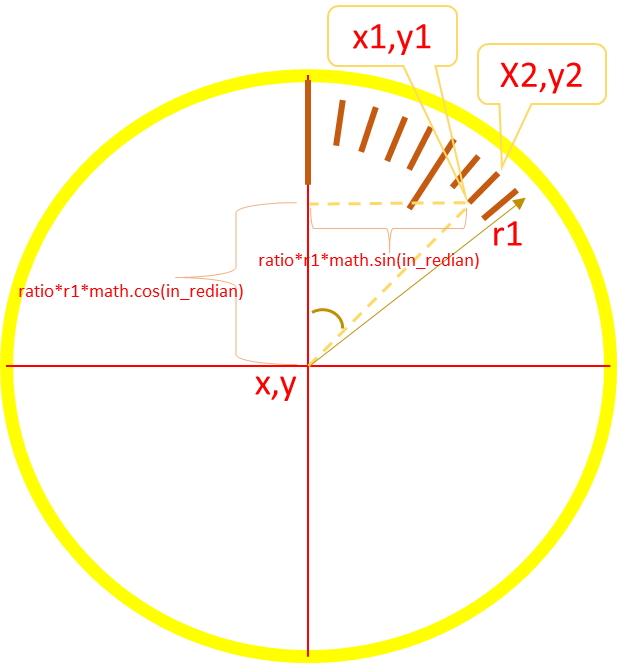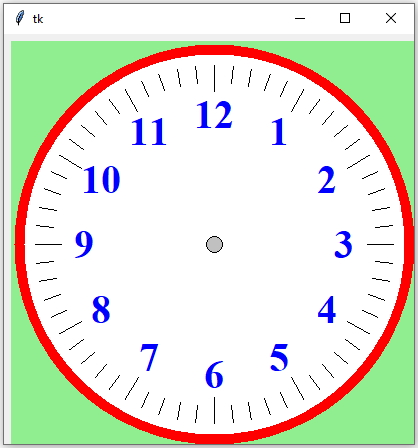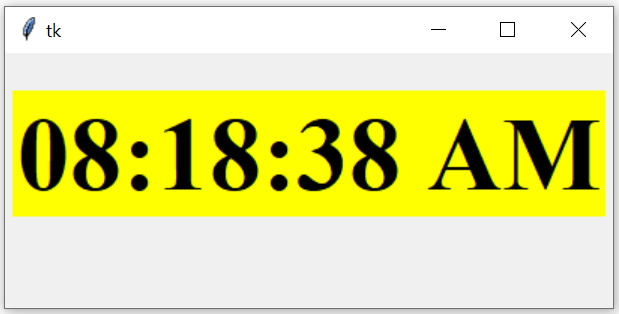Analog Clock Dial

x1=x+ratio*r1*math.sin(in_radian)
y1=y-ratio*r1*math.cos(in_radian)
x2=x+r1*math.sin(in_radian)
y2=y-r1*math.cos(in_radian)
Drawing Analog clock on Tkinter Canvas by showing dial and hour numbers and minute segment markings
| variables | Details |
|---|---|
| r1: | distance from center ( x, y) to outer edge of the lines ( each line shows one second or one minute ) |
| ratio | fraction of full length ( of r1 ) to get x2 and y2. Higer ratio mean small length of lines. This length is more ( less value of ratio ) for all lines after 5 intervals. |
| x,y | Center coordinates. Here x = fraction of full length ( of r1 ) to get x2 and y2. Higer ratio mean small length of lines. This length is more ( less value of ratio ) for all lines after 5 intervals. |
| x1,y1 | Inner edge coordinates of segment lines. |
| x2,y2 | Outer edge coordinates of segment lines. |
| in_degree | Angle in degree. Each segment is 6 degree so to draw the next line the value of in_degree has to be incremented by 6 |
| in_radian | Inputs to sin() and cos() functions value in radian. Value in degree is converted to radian before using with sin() or cos() functions. |
Segments in circle
We have to draw 60 segments within 360 degrees or full circle. Each segment will be drawn after 6 degree of previous segment. Our for loop will start from 0 and will continue till 59. In each step there will be an increment of 6 degree.for i in range(0,60):
.....
.....
in_degree=in_degree+6 # increment for next segment
Angles in Radians
Before using the angle value as input to sin() or cos() functions we have to convert them to radian.in_radian = math.radians(in_degree) # converting to radianif(i%5==0):
ratio=0.85 # Long marks ( lines )
t1=x+r2*math.sin(in_radian) # coordinate to add text ( hour numbers )
t2=x-r2*math.cos(in_radian) # coordinate to add text ( hour numbers )
c1.create_text(t1,t2,fill='blue',font="Times 30 bold",text=next(h)) # number added
else:
ratio=0.9 # small marks ( lines )Adding text for each hours
One iterater object h is created with all numbers and each iteration one number is collected and displayed. As we are staring from 0 angle so the first element is 12.h=iter(['12','1','2','3','4','5','6','7','8','9','10','11']) if(i%5==0):
ratio=0.85 # Long marks ( lines )
t1=x+r2*math.sin(in_radian) # coordinate to add text ( hour numbers )
t2=x-r2*math.cos(in_radian) # coordinate to add text ( hour numbers )
c1.create_text(t1,t2,fill='blue',font="Times 30 bold",text=next(h)) # number added
else:
ratio=0.9 # small marks ( lines )

Full code is here
import math
import tkinter as tk
import time
my_w = tk.Tk()
#my_w.tk.call('tk', 'scaling',200)
width,height=410,410 # set the variables
c_width,c_height=width-5,height-5 # canvas width height
d=str(width)+"x"+str(height)
my_w.geometry(d)
c1 = tk.Canvas(my_w, width=c_width, height=c_height,bg='lightgreen')
c1.grid(row=0,column=0,padx=5,pady=5,columnspan=3)
dial=c1.create_oval(10, 10, 400, 400,width=10,outline='#FF0000',fill='#FFFFFF')
x,y=205,205 # center
x1,y1,x2,y2=x,y,x,10 # second needle
center=c1.create_oval(x-8,y-8,x+8,y+8,fill='#c0c0c0')
r1=180 # dial lines for one minute
r2=130 # for hour numbers before the lines
in_degree = 0
h=iter(['12','1','2','3','4','5','6','7','8','9','10','11'])
for i in range(0,60):
in_radian = math.radians(in_degree) # converting to radian
if(i%5==0):
ratio=0.85 # Long marks ( lines )
t1=x+r2*math.sin(in_radian) # coordinate to add text ( hour numbers )
t2=x-r2*math.cos(in_radian) # coordinate to add text ( hour numbers )
c1.create_text(t1,t2,fill='blue',font="Times 30 bold",text=next(h)) # number added
else:
ratio=0.9 # small marks ( lines )
x1=x+ratio*r1*math.sin(in_radian)
y1=y-ratio*r1*math.cos(in_radian)
x2=x+r1*math.sin(in_radian)
y2=y-r1*math.cos(in_radian)
c1.create_line(x1,y1,x2,y2,width=1) # draw the line for segment
in_degree=in_degree+6 # increment for next segment
my_w.mainloop()
Python Tkinter Projects
Tkinter Text Tkinter Entry How to Validate user entered data

Subhendu Mohapatra
Author
🎥 Join me live on YouTubePassionate about coding and teaching, I publish practical tutorials on PHP, Python, JavaScript, SQL, and web development. My goal is to make learning simple, engaging, and project‑oriented with real examples and source code.
Subscribe to our YouTube Channel here
This article is written by plus2net.com team.
https://www.plus2net.com

 Python Video Tutorials
Python Video Tutorials